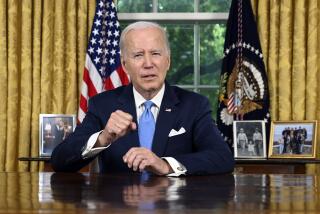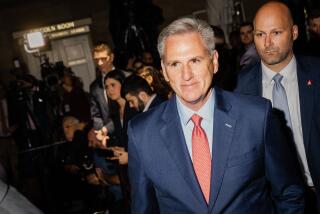U.S. Will Divert Retirement Funds, Raising the Stakes in Debt-Limit Fight
- Share via
WASHINGTON — Treasury Secretary Paul H. O’Neill notified Congress on Tuesday that he would begin tapping federal employee retirement funds this week to prevent the government from breaching its $5.95-trillion debt ceiling.
In a letter to congressional leaders, O’Neill said he would stop investing retirement funds in Treasury securities beginning Thursday and place them in a non-interest-bearing account instead. The funds will be restored about two weeks later, he said, after the April 15 filing deadline generates a flood of income tax payments.
For the record:
12:00 a.m. April 6, 2002 FOR THE RECORD
Los Angeles Times Saturday April 6, 2002 Home Edition Main News Part A Page 2 A2 Desk 1 inches; 32 words Type of Material: Correction
Debt ceiling--A story in the A section on Wednesday stated incorrectly that the Bush administration has asked Congress to raise the federal debt ceiling by $750 million. The administration is seeking an increase of $750 billion.
O’Neill’s move will provide only a brief reprieve, Treasury officials said. Unless Congress votes soon to raise the debt ceiling, within a few weeks the government will again run the risk of defaulting on its financial obligations.
“I know that you share the president’s and my commitment to maintaining the full faith and credit of the U.S. government, especially at this critical time,” O’Neill said in his letter. He urged lawmakers to raise the ceiling “as quickly as possible to avoid any negative repercussions at home or abroad.”
The Treasury secretary promised that government workers “will suffer no adverse consequences” from the fund diversion. His Clinton administration predecessor, Robert E. Rubin, took similar steps in 1995 during a budget standoff with congressional Republicans, O’Neill noted.
Even so, the move shows that Treasury officials are fast running out of room to maneuver while Congress delays a politically awkward vote to raise the debt ceiling in the middle of an election-year debate over tax cuts and deficit spending.
Democrats see the issue as an opportunity to blame President Bush’s tax cuts for the return of deficit spending after five years of government surpluses. Republicans say that last year’s $1.35-trillion tax reduction contributed relatively little to the immediate fiscal crunch, which was accelerated by the recession, the Sept. 11 terrorist attacks and changing budgetary assumptions. But they want to delay a vote on the debt ceiling until it can be packaged with a more politically appealing measure, such as an anti-terrorism funding bill to be taken up in coming weeks.
“This is a totally dysfunctional debate,” said Robert Bixby, executive director of the Concord Coalition, a watchdog group that advocates balanced budgets. “The debt is going up, the debt ceiling has to be raised, and forcing the Treasury secretary to go through such machinations is disgraceful.”
The ceiling, which dates to World War I, has been raised repeatedly over the years as the government’s debts have accumulated. It applies not only to the total amount of Treasury securities held by the public but also to the IOUs issued to government trust funds such as Social Security and the Federal Employees Retirement System. Because the trust funds have been taking in more money than they pay out, the debt ceiling would have to be raised some day even if the government managed to pay off the public debt.
A year ago, the Bush administration said that day would not arrive until 2008 at the earliest. But it began rolling back its projections last fall as the recession caused tax collections to fall and spending on benefit programs to rise, and the war on terrorism caused federal outlays to grow even more.
O’Neill began lobbying Congress late last year to increase the ceiling by $750 million, to $6.7 trillion.
The ceiling was last raised in 1997, but the budgetary standoff preceding the vote forced Rubin to employ a variety of stopgap strategies to avert an unprecedented default on the government’s financial obligations.
Brian Roseboro, assistant Treasury secretary for financial markets, said the temporary diversion of federal employee retirement funds will ensure that the government can make required payments during the first two weeks of April. They include benefit checks totaling $30 billion for Social Security recipients and $18 billion for Medicare and Medicaid participants, $20 billion in income tax refunds, and $6 billion in wages for government employees and military personnel.
Roseboro said the administration had “taken all prudent steps to avoid reaching the statutory debt limit,” including reducing the size of Treasury bill auctions and drawing down cash reserves. Suspending the investment of retirement funds so they won’t count against the debt limit will buy a little time, he said, but Congress will still need to act relatively soon.
“The April 15 tax inflows will only postpone our breaching the debt ceiling for a few months,” he said.
David Wyss, chief economist for Standard & Poor’s, said bond traders regard the current impasse as more of a temporary aggravation than a cause for alarm. Even so, it has a disruptive effect “because you’ve got to change auction schedules, and money gets taken out of that market.”
In the meantime, Treasury officials “have to play games,” Wyss said. “They’ve got to move monies around, they’ve got to borrow from pension funds, they’ve got to do all sorts of other odd things.”
More to Read
Sign up for Essential California
The most important California stories and recommendations in your inbox every morning.
You may occasionally receive promotional content from the Los Angeles Times.










